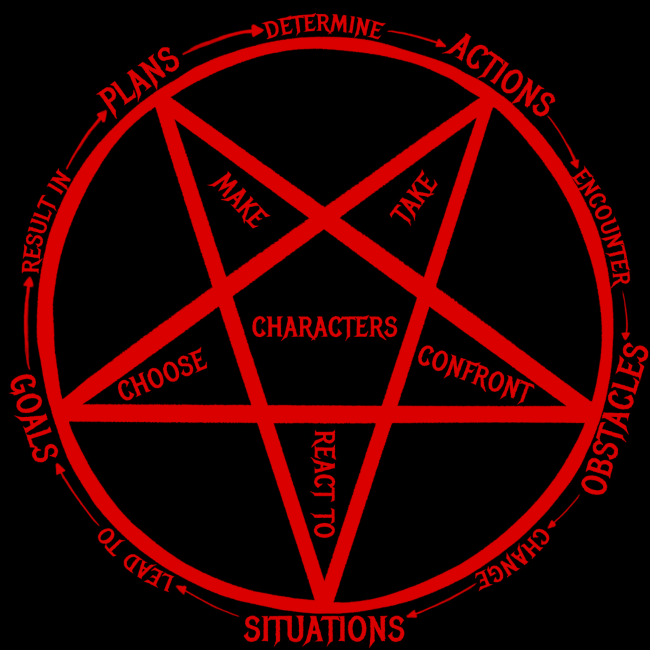The Paths of the Pentacle
Sat Oct 22 2016
Continue now, ye initiate, the studies begun last Saturn's Day into that arcane engine powering the storyteller's dark art, the Pentacle of Plotting.
Our last lesson concerned only the Pentacle's circumference, its Ouroboros ring that drives stories forward. Today, we shall delve into the Pentacle's very heart and probe the ley paths contained therein.
Follow the Paths
The Pentacle's heart holds, within its paths, the secrets of understanding how to imbue your story spells with the power to suck readers into the abyss of your imagination.
The paths are many, and each has a lesson to teach. To find a path, start at any vertex or indeed, with the characters at the center. Proceed thence along the Pentacle's ways to any other such place. Use, then, your own fey skill to weave these elements into a sentence that reveals new truth about the nature of story.
Let's try some.
Starting in the center, proceeding to the leftmost point, then cutting directly across to the rightmost point, we discover that:
Characters choose Goals when confronted by Obstacles
And is it not so, storytellers? For a proper character is resilient! Readers cannot root for a character who, when beset by challenge, gives up! None of that. When beset by challenge, a proper character will take on the new goal of besting that challenge. Nobody likes a quitter.
For another, let us begin at top left, then proceed through the center to the Pentacle's nadir:
Plans made by Characters are reactions to their Situations
Ask yourself, initiate: what are characters? Are they incarnations of chaos, acting with blithe will without regard to consequence or outcome? Or are they incarnations of order, driven by their own innate values to set the world to rights? You well know the answer to that. When characters observe a situation and find it offensive to them, they do not act randomly but make their plans keenly to remove the offense.
One last example. Begin again at the heart. Reach high to the top right, then cut a bold slash to the leftmost point:
Characters take Actions in pursuit of their Goals
Simple, no? And obvious? Of course character stake actions to pursue their goals, because goals do not come true simply by wishing! And yet many initiates have brought to me story spells that have fizzled, asking me why, only for me to discover exactly that they have failed this simple test. Their characters are lazy layabouts, never lifting a finger to achieve their goals, but rather waiting listlessly for others to act on their behalf. Fie on these indolent sloths, and little wonder these spells fail to ensnare the interest of their targets!
The paths of the Pentacle are many. Try your own. Try longer ones that jump from point to point to point. Weave new sentences from them, and see what you discover about the deeper nature of story.
Thus Ends the Lesson
Fun as these past two tongue-in-cheek Halloween articles have been, there is a serious point to them. Understanding the six elements of the pentacle--characters, goals, plans, actions, obstacles, and situations--and how they relate to each other really is the key to developing mastery of storytelling.
Plotting structures like the Hero's Journey, the Snowflake Method, and others are very useful, but at heart they are tools for walking you through the use of these elements without necessarily understanding what they're all about.
The Hero's Journey has its "threshold guardian" figure, blocking the way forward in the quest. But why? Because at that point, the character has:
- become aware of a situation in the world (the main story problem),
- which has led to a goal (fixing the problem in some fashion),
- resulting in a plan for how to achieve that goal. The character has then
- taken some actions towards achieving that goal.
However, easy solutions are dead boring. Stories where the character's plans just work out straight away have no drama to them. Thus, the story needs some kind of an obstacle. Something needs to screw up the plan, so the threshold guardian comes along to serve that need.
Everything in such plotting structures works out similarly. One can write a very creditable story by following such structures, though the story may well feel a little formulaic. Plotting structures only teach you that such elements should occur, but do not teach you why.
Only when you understand the Pentacle's elements and their interrelations will you know why. Only then can you break free of those fixed plotting structures.
When you understand plotting as the cycle of these elements--as small pentacles turning within larger ones, wheels within wheels; as the antagonist's pentacle meshing gear-like with the protagonist's--you will be able to plot your stories more freely and yet still compellingly to readers.

 @p2p_editor
@p2p_editor